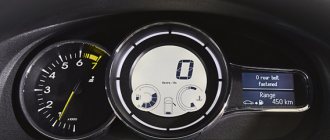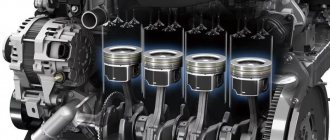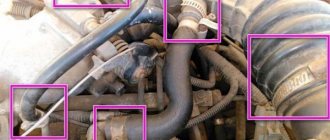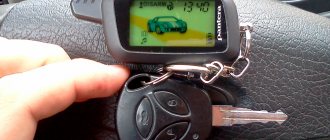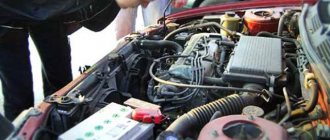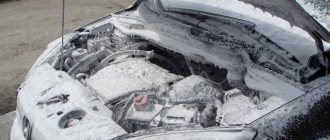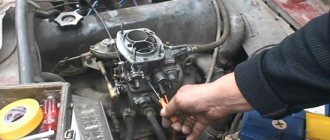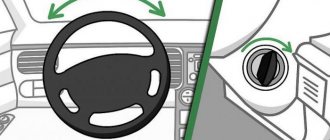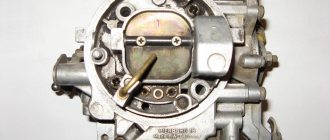Modern vehicle engines provide a mechanism consisting of many parts and mechanisms, each of which needs proper tuning and adjustment.
A fairly common problem among car owners is the continued operation of the main engine - the “heart” of the vehicle, after the ignition is turned off - detonation, glow ignition or dieseling. As a rule, this problem is caused by serious engine breakdowns, which require the fastest possible solution.
To understand why this happens, let's look at it in this article.
The engine does not stall after turning off the ignition
A modern internal combustion engine is a system of many parts and mechanisms, the operation of which requires complex adjustments and settings.
It is not surprising that a deviation in one direction or another can throw the installation out of balance and fundamentally affect its performance and technical condition. One of the most common problems that requires an integrated approach to solve is potassium ignition. The average user observes it when the engine is turned off, when it continues to work for some time, being disconnected from the ignition. This problem is fraught with serious damage later and requires an early solution. In order to understand why this happens, it is necessary to understand its essence, which is what we will try to do.
Summary
As can be seen from the above examples, proper operation is affected by any characteristic, especially when it comes to the overall dimensions of parts. In any case, the problem of why the car does not shut down when the power supply to the power unit is turned off requires prompt intervention and prompt elimination. An attentive attitude towards it will help you understand the reasons why the car continues to operate when you turn off the power key. Having realized after what previously carried out work this breakdown appeared, the car owner will be able to identify and eliminate it, which can significantly extend the trouble-free life of the vehicle. It is better to entrust repairs and selection of spare parts to professionals who will do everything correctly.
Glow ignition
This phenomenon is the ignition of a residual fuel mixture in the engine combustion chamber, which occurs from excessively overheated parts of the power unit. There are many reasons for its appearance, so it is recommended that at the first symptoms you immediately begin troubleshooting and troubleshooting, which can lead to fairly rapid engine failure.
The main reasons for the formation of glow ignition are the following:
- low quality fuel, low octane number contributes to the continued ignition of the fuel mixture after the engine stops running;
- incorrectly adjusted gas distribution system;
- poor-quality cooling system, which contributes to overheating of the car’s power unit;
- spark plugs, few drivers select them correctly according to the required parameters.
It is for these reasons that such a malfunction appears.
When this occurs, the engine must be turned off immediately, rather than waiting for it to turn off on its own. This is done by turning on the second or third speed on the gearbox. Then you need to release the clutch, after which the engine will begin to stall. Do not allow it to continue operating after the ignition is turned off.
With glow ignition, the mixture burns as usual, but a little earlier than the allotted time, and the result is an increased advance angle to the normal value. Because of this, all parts of the combustion chamber begin to overheat greatly.
If you do not eliminate the causes of glow ignition, this will lead to complete breakdown of engine parts after they constantly overheat.
RooTC 10 Aug 2012 10:04
Guys, what if we proceed from the principle of operation of a vacuum seal? What is its main failure - membrane rupture. You can remove the hose from the opposite end from the vacuum valve and bluntly suck or blow in air with your lips. The integrity of the membrane will be felt immediately, or if it is leaky, the air will siphon.
Now this is more interesting. The question is how effective is it?
Is this what is called glow ignition, not diesel spark plugs? In theory, when the engine is stopped, the carb should automatically go to the starting position, while the remote control may be slightly open. Glow ignition occurs due to self-ignition of the mixture from hot cylinder parts, in particular spark plug electrodes
hmm, I’ve been using these spark plugs for a long time, about 40 thousand. 3-pin, which ones exactly - I don’t know. Unfortunately, I don’t know what it’s called correctly, you turn it off, and the engine still shudders a couple of times. Yesterday it practically started up like that.
What to do
Now let's look at the main question - what to do if the engine of a car with a Starline alarm does not stall after turning it off. The algorithm of actions depends on the presence/use of automatic start on the car. And also from connected additional options. For example, if you have Extra Run enabled, the car will continue to run for some time after the ignition is turned off.
Without autostart
In a situation where a car with a Starline A93 alarm does not stall after turning off the engine, follow the instructions below.
Press the brake pedal
While turning off the power, press the brake pedal. The recommendation is due to the fact that in some service stations installers may use a different contact when connecting the hand and foot brake contacts.
Check the ignition switch
If the engine in a car with Starline A93 does not stall, unscrew the steering column and remove the largest connector. Pull out the connectors of the main unit one by one to understand after what action the car will stall. This is the easiest way to determine the problem.
Check problematic items
It often happens that a car with Starline does not stall after turning off the ignition due to vehicle malfunctions. At the same time, Starline has nothing to do with this. Take the following steps:
- Check the serviceability of the power relay and idle speed sensor.
- Make sure the ignition is working properly and inspect the spark plugs.
- Try using a different fuel (higher quality, perhaps even a premium brand).
- Carefully inspect the twists in the places where the alarm wiring is connected. Sharp parts of wires have been known to cut through insulation and lead to bypass targets. As a result, the engine in a car with Starline A93 or another model does not stall.
- Try using engine cleaning additives. They allow you to remove carbon deposits and eliminate the problem if the car does not stall after turning off the engine. Some experts also recommend hydrogenation. But its benefits have not been proven, so don’t risk it.
In most cases, to solve ignition problems, remove the connectors from the mounting block one by one. In this way, you can understand what exactly the problem is - in Starline or in the car itself. Here it is advisable to have a diagram at hand.
With auto start
There are situations when a car with a Starline alarm does not stall after turning off the engine with auto start. The cause may be incorrect system configuration.
Please note that the following wires are connected to autostart and program neutral:
- Orange-violet. Responsible for the position of the handbrake (raised or lowered). If connected correctly and the limit switch is working properly, everything should work. If the handbrake is lowered, the orange-violet wire is suspended and the car stalls. If this does not happen when the ignition is turned off, there are two possibilities - failure of the alarm system or a short circuit in the car wiring.
- Gray-black - engine operation control.
- Yellow - ignition support.
- Blue-black - door control wire.
How to detect a malfunction?
For owners of cars with smart hardware, the task of detecting a problem is greatly simplified. The electronics generate error codes indicating a faulty cylinder.
Cars with and without an ECU need to be checked differently.
Car with ECU
We connect the scanner and start deciphering the error codes
If the code contains an indication of a specific cylinder, you need to pay attention to it first. The problem may be in the spark plugs or in the wiring connected to this cylinder
It's worth checking the gaskets. If error P0300 appears, check the fuel filter and the quality of the fuel mixture used. The reading on the P0204 device indicates damage to the injector.
Many cars, even those made in Russia, are now equipped with electronic units. If the ECU does not work correctly, it is better to replace it. The new “intelligence” must be compatible with the car model. Electronic units can also be installed on old VAZs.
Car without ECU
Finding the source of the problem in cars without an ECU is much more difficult. As a rule, misfire occurs in several cylinders at once. Here, manual checking of the mechanisms is indispensable. First of all, you need to inspect the wiring and spark plugs. The armored wires are checked using an ohmmeter. If the readings are too low or too high, the wiring will have to be replaced. If the readings are normal, you need to measure the compression in the cylinders.
The problem may be with the fuel pump. But if everything is in order with it, you will have to remove the valve covers to determine the condition of the cylinders, piston rings and the valves themselves. In some engines, the valve springs are “buried” deeply. To inspect them, you have to dismantle the cylinder head.
In cars without an ECU, the problem cannot always be detected independently. Inexperienced drivers often have to contact service centers.
Sometimes the spark plugs give a good spark, the fuel supply pump provides normal performance, other mechanisms are also in order - but the issue with the pass remains unresolved
Then you need to pay attention to the electrical circuit of the injectors. The engine may stall both before and after warming up.
For a breakdown to occur, it is enough for at least one wire to be shorted to the injector. This malfunction can manifest itself in different situations - on a cold engine, after it has warmed up. It can also be triggered by vibration.
What is a switch in a car?
A car's ignition system switch is a device that is responsible for coordinating the spark generation process, thereby ensuring stable engine operation at different speeds.
Glow ignition
Many car enthusiasts do not know what glow ignition is. In this article we will tell you what this process is, why it occurs, and describe its symptoms and methods of elimination.
Engine speed jumps at idle: what to do?
The reasons for jumps in idle speed on injection and diesel engines are different. In the article we will look at why speed jumps on engines of various types.
How does fuel consumption depend on the operation of vehicle system controllers?
Having purchased a new car and tried new experiences, the owner sooner or later begins to pay attention to fuel consumption, comparing the passport data with the real state of affairs. Even a novice car enthusiast is aware of the influence of tire pressure or the condition of spark plugs on these figures.
How to identify and eliminate factors of increased fuel mixture consumption
The motorist regularly analyzes the behavior of the car on the road, and the amount of fuel consumed often takes center stage.
Dieseling and glow ignition
The list of main reasons why the engine may not stall after the ignition is turned off includes short circuit and diesel leakage. Dieseling of a gasoline engine is different in nature from glow ignition and occurs as a result of:
- use of low octane fuel;
- increasing the engine compression ratio;
A short circuit is the independent ignition of the fuel-air mixture from hot surfaces (spark plug, exhaust valve, smoldering carbon deposits). Dieseling is also the spontaneous ignition of gasoline, but this phenomenon occurs largely from compression, and only then from contact with heated surfaces. Glow ignition involves disruption of the combustion process of the mixture at the moment when the spark plugs supply a spark. The result is untimely ignition of the mixture, the formation of a flame front in a place unintended by the design, increased loads on the central combustion engine and crankshaft, disruption of heat transfer in the cylinders, etc. Glow ignition is less destructive than detonation, but can also lead to overheating of the pistons, melting of spark plugs, burnout of valves, etc.
We also recommend reading a separate article about how glow ignition can affect engine operation after stopping the internal combustion engine. From this article you will learn about the symptoms and causes of this phenomenon, as well as the main differences between the glow ignition effect and engine detonation.
If the engine does not stop after the ignition is turned off and continues to operate unstably, then this phenomenon is not a short circuit. Moreover, experts in the field of engines, which are structurally based on the principle of glow ignition, note the stability of the operation of such internal combustion engines in any mode. Engines with glow ignition have a distinctive feature, which consists in increased heating of the source of such ignition after the mixture is ignited. Thanks to this property, the glow engine always runs smoothly. In the case of diesel engine, the power unit jerks strongly, that is, such engine operation is extremely unstable.
Part 1 of 3: Electronics Diagnosis
Determine what type of problem you are facing, whether it is electrical or diesel related.
- screwdrivers (with Phillips tip and regular slot);
- repair manual.
Step 1: Determine the type of problem you have
When you turn the key, does it feel like you didn't turn it at all? The engine does not turn off, the dashboard lights up and the parking lights are still on? At the same time, the engine still runs smoothly, so you can turn on the speed and move off. If so, then you have an electrical problem.
But if the engine operation is accompanied by knocking and knocking and when turned off it does not stall, then proceed to point 2 of this instruction.
If the problem is with the electrical part, you need to get into its innards. Remove the bottom half of the plastic steering column cover and locate the ignition switch connector underneath. It may be on the back of the switch itself, or at the end of the electrical cable coming from the switch, and will therefore be slightly further away from the steering column.
Unplug the switch connector and everything should stop after that. If this is exactly what happened, then to solve the problem you will need to replace the ignition system lock.
Step 2: Check the Power Relay
If your vehicle's engine continues to run after disconnecting the ignition switch, you will need to locate the main fuel and ignition system relay. The operating instructions for your car will be a good help in this matter.
In some vehicles this relay may be called an ECM relay, Digifant relay, or DME relay. Although this is a rare occurrence, after turning off the ignition key the vehicle may still be powered due to a stuck main relay. If you finally managed to de-energize the car after removing the relay, you need to install a working one in its place.
Featured Posts
Soldier 0
- From: Ulan-Ude
- Car: TLC 105 & TLC LJ72 3L manual transmission
Soldier 0
Here comes the second problem. After turning off the ignition, the engine does not stall, it jerks at low speeds. I thought it was the discharge valve and changed it, but alas, nothing changed. Maybe I won’t fix it.
Please tell me.
Tomat 6
- From: Russia
- Car: scooter
Tomat 6
- All-wheel drive Toyota maniac
- 6
- 6,749 publications
- From: Russia
- Car: scooter
michelin 9
- From: Don steppes
- Machine: tlc100vx
michelin 9
- I love Toyota
- 9
- 4,010 publications
- From: Don steppes
- Machine: tlc100vx
Try to look at the mass (pigtail harness) between the frame and the engine.
Tomat 6
- From: Russia
- Car: scooter
Tomat 6
- All-wheel drive Toyota maniac
- 6
- 6,749 publications
- From: Russia
- Car: scooter
Try to look at the mass (pigtail harness) between the frame and the engine.
1122021[/snapback]
Very interesting!
what does mass have to do with it?!
VAG 4
- From: Moscow
- Machine: 105 belly tractor
VAG 4
- _
- 4
- 1,731 publications
- From: Moscow
- Machine: 105 belly tractor
Very interesting!
what does mass have to do with it?! wacko.gif
Moreover, the engine is sitting on cushions!
A positive wire goes to the injection pump, therefore, if the ground between the frame and the engine is damaged, then the shut-off valve will not work!
RML 28
- From: Korolev MO
- Machine: TLC100
RML 28
- All-wheel drive Toyota maniac
- 28
- 2,005 publications
- From: Korolev MO
- Machine: TLC100
If you’re on the 80, you can try to do this trick: pull out the ignition key, the engine is running and put the automatic transmission in D, it should stall, it was similar garbage, then it went away on its own, the valve also got stuck, apparently then it sagged….
Soldier 0
- From: Ulan-Ude
- Car: TLC 105 & TLC LJ72 3L manual transmission
Soldier 0
I changed the fuel shut-off valve, it didn't help. I tried to disconnect the chip under the supply valve equipment, but nothing helped either. I reduced the fuel supply and the problem remained.
Tomat 6
- From: Russia
- Car: scooter
Tomat 6
- All-wheel drive Toyota maniac
- 6
- 6,749 publications
- From: Russia
- Car: scooter
Very interesting!
what does mass have to do with it?! wacko.gif
Moreover, the engine is sitting on cushions!
A positive wire goes to the injection pump, therefore, if the ground between the frame and the engine is damaged, then the shut-off valve will not work!
1122052[/snapback]
Sorry, I won’t argue with you, but first study how it works!
The only thing I can tell you is that if you remove the weight of the engine, the valve will still work, but if you still remove the circuit (de-energize it), then even in this case the engine will stall, but it will not continue to work.
Tomat 6
- From: Russia
- Car: scooter
Tomat 6
- All-wheel drive Toyota maniac
- 6
- 6,749 publications
- From: Russia
- Car: scooter
I changed the fuel shut-off valve, it didn't help.
I tried to disconnect the chip under the supply valve equipment, but nothing helped either. I reduced the fuel supply and the problem remained. 1122062[/snapback]
Take the wire off the valve, it looks like the circuit is always energized.
Perhaps you have something like a turbo timer.
If the engine does not stall after de-energizing the valve, then there is something mechanical that is preventing the fuel from being shut off through the channel.
Modified September 24, 2010 by Tomat
Soldier 0
- From: Ulan-Ude
- Car: TLC 105 & TLC LJ72 3L manual transmission
Soldier 0
On D you turn it on forcibly through the red button, it doesn’t stall, it moves little.
Soldier 0
- From: Ulan-Ude
- Car: TLC 105 & TLC LJ72 3L manual transmission
Soldier 0
I threw away the alarm a long time ago; it is no longer needed. And I disconnected the wire, still the same.
Soldier 0
- From: Ulan-Ude
- Car: TLC 105 & TLC LJ72 3L manual transmission
Soldier 0
So, after everything I’ve tried, I bow to the same thing. But what exactly?
Tomat 6
- From: Russia
- Car: scooter
Tomat 6
- All-wheel drive Toyota maniac
- 6
- 6,749 publications
- From: Russia
- Car: scooter
I threw away the alarm a long time ago; it is no longer needed.
And I disconnected the wire, still the same. 1122068[/snapback]
I repeat once again, turn off the power to the valve!
See above!
Soldier 0
- From: Ulan-Ude
- Car: TLC 105 & TLC LJ72 3L manual transmission
Soldier 0
After turning off the ignition, I remove the wire from the valve, it doesn’t help. Even when blocking the air intake it does not want to stall.
Tomat 6
- From: Russia
- Car: scooter
Tomat 6
- All-wheel drive Toyota maniac
- 6
- 6,749 publications
- From: Russia
- Car: scooter
After turning off the ignition, I remove the wire from the valve, it doesn’t help.
Even when blocking the air intake it does not want to stall. 1122075[/snapback]
It remains only mechanically, the valve cannot block the channel.
Lyokha Yurich 19
- From: Moscow
- Car: Ford Focus ZX5, leather-face...
Lyokha Yurich 19
- All-wheel drive Toyota maniac
- 19
- 1,017 publications
- From: Moscow
- Car: Ford Focus ZX5, leather-face...
how did it start?
they fell a couple of times on plungers (new) with a crookedly made channel (Denso ORIGINAL), so the valve physically could not block the discharge channel of the plunger, and the flow was still there = they did not stall or stalled in convulsions and for a long time...
Soldier 0
- From: Ulan-Ude
- Car: TLC 105 & TLC LJ72 3L manual transmission
Soldier 0
Greetings. Everything is as usual, I came home. In the morning I drove the car, turned off the ignition, but it didn’t stall. So I'm trying to find the reason.
Lyokha Yurich 19
- From: Moscow
- Car: Ford Focus ZX5, leather-face...
Lyokha Yurich 19
- All-wheel drive Toyota maniac
- 19
- 1,017 publications
- From: Moscow
- Car: Ford Focus ZX5, leather-face...
When you changed the valve, did you remove the core?
there was no fine “chip dust” adhering?? (the valve mesh lets it through)
Soldier 0
- From: Ulan-Ude
- Car: TLC 105 & TLC LJ72 3L manual transmission
Soldier 0
When installing, I washed everything, there was no foreignness.
Lyokha Yurich 19
- From: Moscow
- Car: Ford Focus ZX5, leather-face...
Lyokha Yurich 19
- All-wheel drive Toyota maniac
- 19
- 1,017 publications
- From: Moscow
- Car: Ford Focus ZX5, leather-face...
and the rubber band on the core without damage or “gnawed out” ???
or didn't you look??
What could be the reason if the engine does not stall after turning off the ignition?
When you turn off the ignition, you expect the engine to stop! And you will be very upset if this does not happen. If the engine continues to operate the same way as before the ignition switch was turned off, as if it had never been turned off at all, then its fuel and ignition systems have not been turned off. In this case, your vehicle has electrical problems that need to be fixed. It is also possible that the ignition switch or power relay needs to be replaced.
In addition, it happens that the engine cannot stop immediately and instead begins to run jerkily, making knocking and squeaking sounds, also known as “dieseling” or “glow ignition”. This phenomenon occurs when there is something hot enough in the combustion chamber of the engine to ignite the residual fuel in the engine. The phenomenon received this name due to its similarity to the operation of a diesel engine, in which the fuel is ignited without the use of spark plugs powered by electrical energy. This usually does not happen with modern injection engines, but in the “dark” era of carburetors, drivers often encountered this problem.
If your car has a diesel problem, there are a few steps you will need to take that can help you understand what's going on with your car. You may be able to solve the problem with a few small adjustments.
Site about SUVs UAZ, GAZ, SUV, CUV, crossovers, all-terrain vehicles
In case of problems, the ignition switch is checked for correct closure of the contacts at different positions of the ignition key, as well as the operation of the anti-theft and blocking devices against reactivation of the starter while the engine is running.
Checking and troubleshooting the ignition switch.
To check the correct closure of the contacts, you should alternately connect the test lamp wire to each of the switch terminals, and connect its second wire to the vehicle ground. In the same way, you should check terminal “30”, to which voltage from the battery and generator is usually supplied.
The locking rod of the anti-theft device must extend if the key is set to position “III” - parking, or “0” - on cars of the VAZ-2110 family, and recessed after turning the key to position “I” - ignition. The key should be removed from the lock only in position “III” or “0” - on cars of the VAZ-2110 family.
Switching diagrams, location and marking of ignition switch terminals 15.3704, 2105.3704100, 2108.3704005-40.
The locking device must not allow the key to be turned from position “I” - ignition, to position “II” - starter. Such a turn should only be possible after first returning the key to the “0” position on all vehicles.
Ignition switch repair.
For repairs, the ignition switch must be removed and disassembled. The sequence of disassembly and assembly of different models of ignition switches may differ slightly. The ignition switch with the contact part located inside the housing is removed and disassembled in the following sequence:
Dieseling and glow ignition
Both short circuit and dieseling are similar to each other - as in the first and second cases, the engine does not stall immediately after turning off the ignition.
However, diesel engine dieseling differs from short circuit and can occur as a result of:
- With an increased engine compression ratio;
- When using low octane fuel.
Glow ignition - the air-fuel system continues to operate independently, which is caused by contact with glow plugs or other hot elements of the fuel system. Dieseling is also the spontaneous ignition of gasoline. But in this case, the operation of the engine after it is completely turned off and the keys are removed from the ignition is affected by the compression level, and only after that by the hot surfaces.
Note that compared to detonation, glow ignition causes less harm. But, as mentioned above, it can ignite in inappropriate places, which leads to melting of the spark plugs, overheating of the pistons, and so on.
If the “heart” of the car works “unevenly” after turning off the ignition, then this is definitely not a glow ignition. Short circuit has one feature - the motor in any case works without jerking.
In the case of diesel engine, the engine will jerk strongly and run unevenly.
It is worth saying that dieseling is a problem that is more common in cars that have engines with a high compression level. This problem can also occur if the cooling system is faulty.
Important! Older power units, which have a somewhat low compression ratio, are generally not dieselized.
It is also worth adding that most modern engines operate on the principle: turning off the ignition means completely cutting off the fuel supply. If the new vehicle “twitches” after being completely turned off, then there is a possibility of problems arising in its certain power points. Another possible cause is a breakdown of the blocking systems.
Consequences
Engine detonation leads to a shortened engine life. Such a power unit is capable of traveling a maximum of 100,000 kilometers, after which the cylinder block or cylinder head will simply fall apart.
Too strong a detonation leads to instant destruction of the power unit. It will simply be blown to pieces. The cylinder head gasket fails first. It will be able to withstand one single detonation, after which it will burn out and leak oil and antifreeze.
If you have been driving a car with a knocking engine for a long time, then the following solutions await you at the service station:
- replacing the cylinder block;
- changing the crankshaft;
- installation of a new cylinder head and piston group.
However, all these problems can be avoided if you take care of the engine and attend service on time. It is necessary to change the oil every 7 thousand kilometers, and fill only high-quality AI 95 gasoline at proven gas stations.
Cleaning the lubrication system using flushing
When the engine does not stall, only a professional line can help to solve the problem. Be sure to flush the engine to remove various deposits and sludge.
Pro Line Motorspulung provides fast and highly effective flushing of the oil system of diesel internal combustion engines, incl. equipped with turbocharging, is a high-tech combination of special additives with detergent-dispersing properties.
It allows you to remove solids that do not dissolve in regular oil from coked piston rings and oil pump parts within 10-15 minutes.
To carry out deep cleaning, it is enough to pour 100 ml of the product into the engine before changing the oil. flush for every liter of oil and run the engine in idle mode for 15-20 minutes.
After this, the old oil and flushing agent must be drained, and then the oil filter must be replaced and fresh oil must be added.
Replacing with diesel oil for efficient engine operation
After cleaning, it is necessary to apply oil, which will provide the best lubrication and protection to the parts. For diesel engines, try to choose products with ACEA B4/B5 C3 classification, that is, which are intended only for diesel engines.
The additives are washed so effectively that carbon deposits do not have time to accumulate.
Top Tec 4200 diesel is a high-performance diesel synthetic motor oil obtained by hydrocracking from mineral raw materials, practically does not form soot, and is characterized by a unique combination of a high viscosity index (more than 160 units) and a high degree of fluidity. Which, in turn, allows you to operate the car in all road conditions, even extreme ones, in a wide temperature range from –50 to +40°C.
Thanks to the combination of these properties with good thermal-oxidative stability, the interval between replacements can be up to 20,000 km.
The use of this product helps to extend engine life, save fuel, minimize noise and increase the service life of the exhaust gas aftertreatment system (including DPF particulate filters). Recommended for most models of modern diesel internal combustion engines.
Stabilize viscosity to help oil
When it is not possible to change the oil, use a special additive to stabilize the viscosity characteristics.
By using the Visco-Stabil additive for diesel motor oils, it is possible to stabilize pressure and viscosity indicators in high temperature and cold start modes. Helps increase compression and reduce noise, as a result of which it is especially recommended for use in engines with high mileage.
Thanks to the use of Visco-Stabil, the density characteristics of the oil are optimized and its waste is prevented. The product is compatible with all types of motor oils (mineral, semi-synthetic, PAO and HC synthetics). Filling into the engine is carried out as needed at the rate of 300 ml of Visco-Stabil product per 5 liters of oil.
The engine knocks after turning off the ignition - reasons
Most often, engine detonation when the ignition is turned off occurs due to unsuitable fuel: its octane number is lower than that provided for by the technical requirements of the creators of a particular engine. The thing is that low-octane fuel is used for engines with a lower compression ratio. Thus, if the type of gasoline does not match the type of engine (for example, it is necessary to use A-95, but instead A-76 is poured), then its active combustion occurs (almost at the speed of an explosion).
During active combustion, quite a lot of thermal energy is released, which as a result does not have the best effect on the operation of the entire system and on the condition of the engine.
Another reason why the engine knocks when the ignition is turned off may be too early ignition. Most often, it is installed so that the engine is more sensitive to the opening of the throttle valve, but in this case the air-fuel mixture ignites earlier during the upward movement of the piston, which leads to excessive overheating. This process can also be triggered by engine overheating and installation of inappropriate spark plugs.
